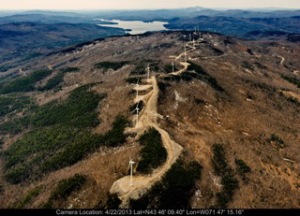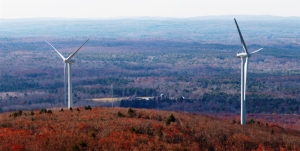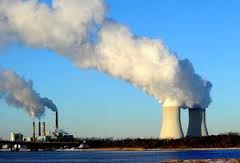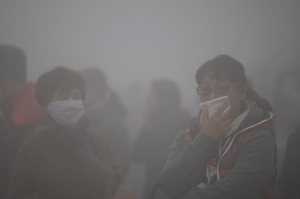Mark Twain famously warned, “Never let the facts get in the way of a good story.” Miles Grant carefully heeded Twain’s advice in his recent opinion about global climate change and wind opposition, . Grant is fairly brimming with religious fervor when he argues that wind power is necessary for reducing climate change. So much so, in fact, one might fairly say, he’s full of it!
The problem with Grant’s argument is that it assumes facts that are not in evidence. Wind turbines do not reduce CO2 emission, they increase it. In 2013, the U.S. spent some $80B subsidizing wind power, but CO2 only increased. In proportion to their economies, other industrialized nations around the world have invested far more heavily in wind energy than the U.S., but carbon emissions are still on the rise.
Part of the reason for this is that the energy from about 60% of the world’s power grids is supplied by coal, and all industrial turbines must be connected to a grid. Power grids must manage a careful balance between energy supply and demand. When wind turbines are spinning, the government requires coal generators to be slowed to balance the grid. This is called curtailment. When the turbines stop spinning, the coal plant production must be ramped back up again to preserve the balance of supply and demand. This process, called cycling, can take hours because coal generators ramp up very gradually.
The problem with cycling is that even the most efficient coal plants produce much greater CO2 emissions when they are not running at peak efficiency. As a result, wind farms connected to coal grids virtually ensure increased CO2 emissions—not to mention increased particulate air pollution—a dirty little secret that nobody wants you to know.
Grant mentioned the people who have to breathe the pollutants being belched out of the Brayton Point coal plant, but he forgot to mention the fact that connecting wind turbines to the same grid will make it much worse. The misguided demonstrators who marched into Fairhaven last year to support the turbines here clearly didn’t understand this danger either. The people who are being harmed by pollution from this coal plant should be doing everything in their power to prevent further turbines from being connected to the same grid.
People like Grant, who look at wind power through jade-colored glasses, will be quick to argue that at least coal is not being burned when turbines generate power. Unfortunately, this too flies in the face of the macroeconomic facts. The U.S. has become an exporter of its coal surplus. The principal consumer of this surplus is China. When the Chinese burn our coal, however, their plants do not have to comply with EPA standards. As a result of these dirty coal plants, some industrialized cities in China now have local pollution so bad that the air is unbreathable for days on end. At least we can all agree on one thing; the climate is global, so we’re all breathing some of this pollution, too.
Here are some other facts that the green zombies don’t want you to know. Every living plant growing in huge swaths of land are literally razed to the ground every time a wind turbine goes up. It isn’t just the ten acres needed for the site that get turned into a moonscape, either. Broad fire lanes and paved roads are often cut across ridges and mountain tops to accommodate the immense vehicles needed to build, service, and maintain these mechanical leviathans. The forest habitat is virtually hacked to ribbons that can no longer support the integrated native ecology of flora and fauna. Take a look at the wind farms in New Hampshire, Vermont, and Maine with Google Earth to see the true extent of environmental destruction cause by industrial turbines.

An aerial shot of the Groton Wind Project in New Hampshire. (Click for a full tour of the ecological devastation.)
Another impact that the Mr. Green Jeans won’t mention is the economic one. In the U.K., wind power has driven the cost of electrical energy so high that a new class of poverty has emerged. More and more people are slipping below the poverty line, because they can no longer afford the high cost of electricity produced by turbines. In the global economy, the worst impact is placed on those who are already languishing in poverty.
In proportion to its economy, Germany has invested more in wind than any other industrialized nation. Once the powerhouse of the E.U., its economy has been ravaged by its gamble on the roulette wheel of wind. According to government-paid researchers, the wind energy misadventure known as the Energiewende (energy transformation) has damaged the German economy so badly, that the Germans are bringing ten new coal generators online and more are planned.

The $6-million-dollar turbines in Princeton, MA.
Princeton, MA, one of the earliest adopters of wind power in Massachusetts, has now reported a loss of $6 million, and has the highest electric rates in the Commonwealth.
Though the cost of wind energy is hidden by federal subsidies paid for with your tax dollars, a kilowatt of energy from a land-based turbine costs three times more to produce than conventional generators; and from offshore turbines, three times more than that, again. If Cape Wind is ever built, carbon emissions will continue to rise and Massachusetts will have the highest electric rates in the U.S.
By far the greatest cost of all, of course, is the human one. There is certainly no benefit to wind power sufficient to justify the damage to human health and well-being they cause. Wind turbine sites are ecological dead zones. The best science we have offers clear and compelling evidence that virtually everyone exposed to intense infrasound of the kind produced by industrial wind turbines will begin to suffer from cognitive impairment and/or cardiovascular disease. Turbines are a silent killer. Abandon hope, all ye who enter.
Contrary to the green dogma, the fact is that wind power doesn’t make sense whether you believe global climate change is real, or not. In the end, Grant’s fantasy-in-green isn’t even a good story. It’s just a fractured fairy tale, full of sound and fury, signifying nothing.
Curt Devlin, Fairhaven, MA

